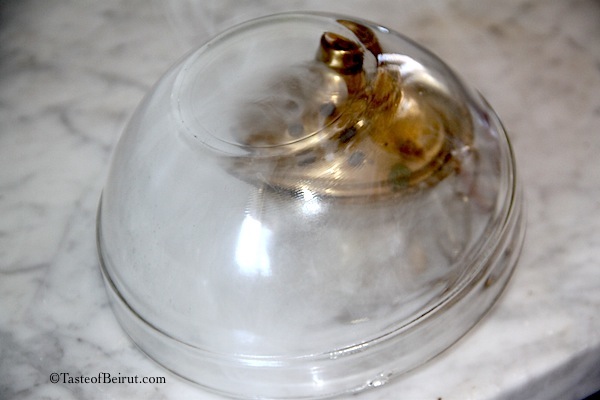Incense flavored food
September 28, 2013 • Category: Main Dish

Food has been flavored with incense in Lebanon, in communities across the board; usually, pastries, such as maamoul or pudding such as khabeessa ( a walnut studded jelly made with grape molasses or plain sugar); a popular drink too, jellab, based on date and raisin molasses is incense-flavored.
In any case, flavoring food with incense is not difficult. It is simply a matter of heating a couple of pieces of coal till incandescent, topping them with the incense stones of your choice immediately releasing an intoxicating aroma of heavy incense; to secure the incense, I went to a general store in Beirut which claimed it was the original one; never mind, they are all the original ones and sell everything under the sun from fertilizers to spices to gardening tools; in addition, they are all decked with a generous amount of dust and memories.
1. Heat the coal piece (or pieces).
2. As soon as it is red-hot or incandescent, transfer to the vessel you are planning to use (it could be just a solid metal incense-burner or bowl or solid glassware. Top it with the incense pieces to allow them to smoke.
3. To infuse the dessert or dough or pudding, cover with a bigger bowl for about 15 minutes; this is sufficient time for the food to be take on the taste of the incense. Adjust the time according to your taste and desire.
Comments
14 Comments • Comments Feed




deana@lostpast says:
I would love to know what they use for the incense??? What are the perfumes they use for the smoke?
On September 28, 2013 at 4:21 am
Joumana says:
@Deana, Maija, Alicia: The incense stones I bought at the store released a very strong church fragrance; I imagine one can get different scents, depending on the bark of the tree being used. I will ask the man at the general store next.
On September 28, 2013 at 11:58 pm
Maija Haavisto says:
Very interesting! Which fragrances would you recommend for this?
On September 28, 2013 at 4:31 am
Alicia (foodycat) says:
That is so fascinating! And modern British chefs think they are being so modern and innovative doing just the same thing! Does it matter what sort of incense you use? I’d be a bit worried about using the cheap nag champa sticks we buy!
On September 28, 2013 at 6:11 am
Rosa says:
That is very interesting! Those incense infused dishes must have an unique flavor.
Cheers,
Rosa
On September 28, 2013 at 11:59 am
Gabi says:
Great images. I’m really impressed. Think I can smell the fragrance through the net. The incense available locally I would hardly dare to use for internal consumption. Nothing but chemistry I’m afraid. Maybe I’ll have the chance to experience the real stuff some time.
On September 29, 2013 at 4:28 am
Belinda @zomppa says:
A wonderful idea – love the smell, but never thought to infuse food!
On September 29, 2013 at 3:17 pm
Laura@Silkroadgourme says:
Fabulous! I love this post! Love to learn from you, Joumana! THX!
On September 29, 2013 at 10:32 pm
Nuts about food says:
Learned something new again!
On October 3, 2013 at 4:30 am
Tim Friese says:
Wow, this is new to me. Thank you for the post!
On October 21, 2013 at 8:05 pm
Rami says:
During Easter, my mother uses this incense to infuse the walnut filling for the ma’amoul pastries; it gives it an almost ecclesiastical feel. I believe the incense that is typically used is Bakhour al Jouri.
On March 9, 2014 at 10:47 pm
Joumana says:
@Rami: Thanks for providing the name! I found a store that sells all kinds of incense from the KSA to India but they did not tell me what type to use for ma’amoul.
On March 9, 2014 at 11:19 pm
Ruru says:
Interesting post. Can you please provide a link to buy the incense. Thanks in advance
On February 17, 2017 at 3:36 am
Stephen says:
Hello there!
I like this idea seems fantastic, I’ll be sure to hold onto this tip.
I was also inquiring to see if i can use that picture for personal purposes!
Thanks for your time! Take care everyone.
On September 18, 2018 at 6:01 pm